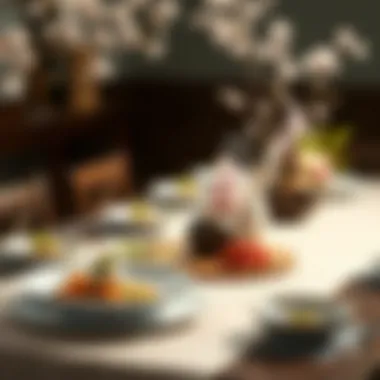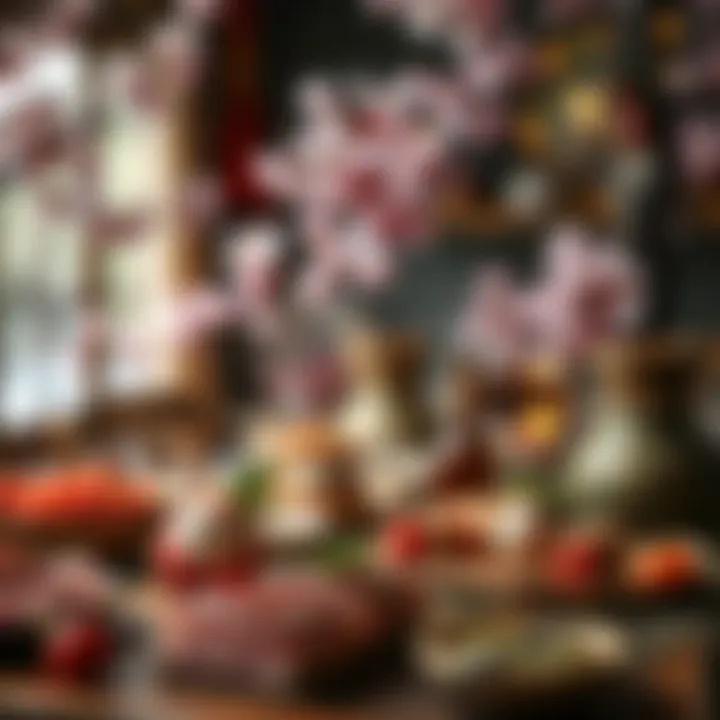Sakura Christmas Dishes: Blending Tradition with Innovation


Intro
The festive season of Christmas, often characterized by glistening lights and the aroma of baked goods wafting through the air, also ushers in exciting culinary traditions. However, this year, there’s a delightful twist. Friends, family, and food enthusiasts alike find themselves captivated by the ethereal beauty of sakura, the Japanese cherry blossom. This delicate bloom, rich in symbolism and flavor, has begun to weave its way into Christmas kitchens around the world.
So, what happens when the depth of Japan’s sakura traditions meets the universal joy of Christmas feasting? The result is an enchanting fusion of flavors and aesthetics. Imagine a snowy white tree adorned with vibrant pink cherry blossoms, symbolizing renewal, hope, and beauty while also retaining the warmth of classic holiday fare. It’s a recipe that invites creativity and exploration, merging unique cultural narratives and innovative culinary practices.
In this exploration, we will delve into the culturally significant elements that sakura represents and the inspirations it brings to holiday recipes. From traditional dishes dressed in whimsical sakura flavors to contemporary takes that push the boundaries of creativity, this journey aims to provide food lovers with engaging and practical ways to elevate their festive meals.
Join us as we sift through time-honored recipes, share practical cooking tips, and crown innovative adaptations that embody the spirit of sakura in your next Christmas celebration. By the end, you’ll be well-equipped to charm your loved ones with unforgettable dishes, merging rich tradition with delightful creativity.
Prelims to Sakura and Christmas Cuisine
Exploring the fusion of sakura with Christmas cuisine offers a unique perspective on both cultural traditions and culinary innovation. Sakura, or cherry blossoms, hold deep meaning in Japanese culture, symbolizing the transient beauty of life and renewal. On the other hand, Christmas traditions span across the globe, embodying warmth, family bonds, and celebration.
By merging these elements, one creates a beautiful tapestry of flavors and aesthetics. Think about the scent wafting from sakura-infused dishes sitting at a festive table where laughter and joy abound. This delightful intersection of flavors not only pays homage to historic practices but also opens doors for creativity during the holiday season. It encourages cooks and food enthusiasts to rethink and refresh traditional recipes with the essence of sakura, prompting a delightful blend of East and West.
Moreover, adopting sakura influences encourages a sensory experience beyond just taste. It calls to the eyes and nose, elevating ordinary meals into extraordinary events. Visually, dishes featuring sakura can captivate diners with their hues of pink, while the subtle floral notes can add a freshness that's often absent in typical Christmas fare. When guests gather around the table, the combination of traditional and innovative awakens conversations about culture and culinary art, weaving together the old and the new.
In summary, the significance of introducing sakura into Christmas cuisine not only enhances flavor profiles but also opens discussions about the bridging of traditions, uniting them into a cohesive and meaningful dining experience.
Cultural Significance of Sakura
Sakura is not just a flower; it's a phenomenon deeply rooted in Japanese nature and culture. Historically, it represents the fleeting nature of life, marking the arrival of spring and the conclusion of winter. The blossoming of these flowers is greeted with festivals and celebrations, bringing communities together to appreciate beauty and nature. This cultural touchstone resonates with many and offers a profound understanding of life's transitory beauty.
The use of sakura in culinary arts extends this appreciation to food, where each dish embodies the essence of seasonal beauty. Incorporating sakura into Christmas dishes can symbolize hope, renewal, and the importance of savoring every moment.
Christmas Traditions Around the World
Christmas, a festival celebrated across diverse cultures, brings with it an array of traditions and dishes. From gingerbread houses in Germany to feast of seven fishes in Italy, each country brings its own flavor to the festive table.
In the United States, roasted turkey or ham tends to hold center stage, while in Sweden, julbord, featuring herring and various meatballs, is common. Such dishes carry their own stories, reflecting local heritage and communal bonds.
As one contemplates the various Christmas traditions, blending these with sakura-infused dishes enriches the culinary landscape. This blend of styles not only creates unique dishes but can also stimulate conversations that celebrate the global nature of Christmas, inviting insights into shared endeavors and experiences around the table.
The Aesthetic Appeal of Sakura in Culinary Arts
The introduction of sakura, or cherry blossom, in culinary arts goes beyond mere decoration; it encapsulates a profound blend of visual appeal and complex flavor profiles. The aesthetic allure of sakura plays a significant role in setting the scene for festive occasions, particularly during Christmas when families gather around beautifully decorated tables. Incorporating sakura into holiday dishes not only elevates the dining experience but also connects participants with seasonal essence. This intersection of visual charm and gustatory delight creates a multi-sensory experience that resonates with both historical significance and modern creativity.
Visual Presentation of Dishes
The visual component of food often dictates our initial reactions to a meal. When it comes to sakura, its delicate pink petals offer an enchanting contrast against savory or sweet backgrounds. In dishes, these blossoms can be used as garnishes, ground into powders, or steeped to infuse colors. Imagine a Christmas ham topped with soft pink sakura petals, glistening in the warm light of holiday candles.
Several strategies can enhance the appeal of sakura-adorned dishes:
- Color Contrast: Pair sakura with both vibrant and muted tones. For instance, a richly-colored beet salad can effectively highlight the soft pink of sakura.
- Layering Textures: Use sakura petals alongside crunchy elements, like toasted nuts. This combination engages various sensory experiences, appealing to sight and taste alike.
- Plating Techniques: A minimalist approach often works best, where the sakura blossoms can take center stage – perhaps a simple rice dish scored with a sakura-infused drizzle creates ample visual intrigue.
"Good presentation is not just about how the food looks on the plate but also about how it evokes emotions and memories related to the dish's origin and ingredients".
Ultimately, the use of sakura adds an extraordinary level of sophistication, making dishes resonate with the festive spirit of Christmas.
Sakura as a Flavor Component
While the beauty of sakura is undeniable, its impact on flavor should not be overlooked. Often, sakura has a mild sweetness with hints of almond or marzipan. This unique profile can be transformative when incorporated thoughtfully into traditional Christmas recipes.


When using sakura as a flavor element, consider the following:
- Balancing Act: The gentle sweetness of sakura can serve as a counterpoint to richer flavors, such as roasted meats or creamy sauces.
- Infusion Methods: Sakura can be steeped into broths for soups or blended into creams for cakes. For example, a sakura-infused gravy could beautifully accompany a turkey, adding a hint of sweetness that cuts through the meat's richness.
- Herbal Pairings: Complement sakura with other botanicals, such as rosemary or thyme. These combinations can create innovative flavors that embody both warmth and freshness, perfect for the holiday season.
In summary, when merging the visual splendor of sakura with its unique flavor profile, chefs are given a splendid opportunity to craft memorable culinary experiences. This approach embodies a celebration of tradition, while also inviting creativity that modern palates crave.
Traditional Christmas Dishes Reimagined
Reimagining traditional Christmas dishes through the lens of sakura influences offers a fresh perspective on festive cuisine. This section emphasizes the beauty of merging two seemingly disparate traditions, ultimately creating a unique dining experience. It encourages culinary enthusiasts to explore alternative flavors and showcase their creativity in the kitchen. The foundation of this exploration lies not only in the aesthetic appeal but also in the depth of taste that sakura can bring to classic recipes.
Sakura-Inspired Roasted Meats
Methods for Infusing Sakura Flavors
To introduce sakura flavors into roasted meats, several methods can be employed. One popular approach involves using sakura tea leaves as a marinade base. For instance, in Japan, chefs will often create a brine using sakura-infused water, allowing the meat to absorb the floral notes before cooking. The delicate floral scent complements the protein while enhancing the natural richness of dishes like roasted duck or chicken. Care should be taken, however; too much sakura can overwhelm the dish. The key characteristic here is balance. If done right, it adds a whole new dimension to the flavor profile.
Another method is smoking meats with sakura wood chips. This technique imparts a subtle fragrance that elevates the meat without drowning out other flavors. It’s a choice that showcases the versatility of sakura while also calling attention to traditional cooking methods used in Japanese cuisine. The unique feature of this technique is its ability to create depth, often leaving diners guessing about the source of those rich flavors. However, using wood chips requires some finesse; a novice might unintentionally mask the meat's natural taste with overly aggressive smoke.
Pairing Ingredients
When it comes to pairing ingredients, selecting items that harmonize with sakura is crucial to the overall success of a dish. Ingredients such as soy sauce, mirin, or citrus can enhance the sakura’s delicate floral notes without overshadowing them. For example, a citrus glaze might complement a sakura-marinated chicken, bringing a refreshing tang that counterbalances the floral essence.
The key characteristic of pairing ingredients lies in their complementary nature. A judicious combination leads to a dish where each component enhances the others, paving the way for a well-rounded flavor. Moreover, seasonal vegetables such as asparagus or delicate peas can provide a fresh crunch and visual contrast. The unique feature of careful ingredient pairing is its potential to build complexity; however, it could also pose a risk if the combinations acquired overpower the sakura, diminishing its subtle beauty.
Sakura-Infused Sauces and Gravies
Crafting the Perfect Sauce
Crafting the perfect sakura-infused sauce requires an understanding of how to marry flavors effectively. A successful sauce can elevate any meal, and using sakura essence adds an unexpected twist. A classic sauce can be transformed by simply incorporating sakura petals, perhaps in a beurre blanc or a basic gravy. This adaption not only enhances the visual aspect of the dish but also introduces a light, aromatic flavor profile that draws the eye and palate.
The key characteristic here is the sauce's ability to bind the meal together. Using sakura essence offers a fragrant accent that deepens the sensory experience. However, achieving a balance between the floral taste and richness requires practice. The advantage of this approach is the added elegance it brings to the table, making even a basic roast feel extraordinary.
Complementary Dishes
Complementary dishes serve to highlight the sakura-infused sauces, creating a cohesive gastronomic theme. Dishes such as roasted root vegetables or a light rice pilaf can absorb the flavors and add extra texture. The beauty of pairing such dishes lies in their capacity to enhance the dish while not competing against it. This creates a fuller dining experience where various elements share the spotlight.
What makes these complementary dishes a wise choice for this article is their adaptability. Almost any vegetable or grain can be infused with a sakura essence using either cooking methods or sauces, making experimentation accessible for home cooks. The unique feature here is simplicity; these dishes require minimal effort but can greatly enhance an overall meal. This juxtaposition allows for creativity without requiring intricate culinary skills, thus appealing to a broad audience.
Creative Side Dishes with a Sakura Twist
Seasonal Vegetables
Incorporating seasonal vegetables into sakura-themed dishes not only highlights the freshness of the produce but also enhances the visual aesthetic of the meal. Dishes such as roasted purple carrots or sautéed green asparagus can benefit from a sprinkling of sakura petals to add both color and flavor. The key characteristic of seasonal vegetables is their peak flavor—when harvested at the right time, they can be the highlight of the overall dish. Utilizing them in the context of a sakura meal amplifies a connection to nature and the changing seasons.
Moreover, using vegetables in this way encourages a healthy component to festive meals. As side dishes, these seasonal vegetables let guests enjoy lighter options, all while complementing richer main courses. An unexpected downside might be the limited availability of certain seasonal produce, depending on local climates. Therefore, understanding what is in season can make all the difference.
Unique Combinations
Combining traditional flavors with sakura can yield remarkably unique side dishes. For example, mixing roasted yams with sakura-infused maple syrup creates an unconventional yet flavorful blend, providing sweetness that pleasantly contrasts savory profiles. Special combinations like this show how varied flavors can create a new twist on traditional recipes.
The key characteristic is innovation in combining flavors that wouldn’t normally appear together. Introducing an element of surprise, such as the sakura, enhances the celebration. The unique feature of this creativity lies not only in taste but also in artful presentation. It allows hosts to showcase their culinary skills and make a memorable impact. Still, the challenge remains in ensuring that novelty doesn’t detract from the foundational essence of the original dish. Striking the right balance requires experimentation and intuition.
Desserts Celebrating Sakura at Christmas


Desserts play a pivotal role in any festive celebration, and Christmas is no exception. In this context, incorporating sakura, or cherry blossom, into traditional Christmas desserts introduces a unique twist that reflects both cultural heritage and culinary creativity. These desserts not only tantalize the taste buds but also enhance the visual appeal of festive gatherings. As we explore the world of sakura-infused desserts, we will delve into how this beloved ingredient can reinterpret classic treats, providing an opportunity to celebrate cultural intersections in an enjoyable and delicious manner.
Sakura Mousse and Puddings
Sakura mousse and puddings are delectable representations of how light and airy textures can elevate traditional desserts. The incorporation of sakura into these creamy delights creates a floral note that beautifully contrasts the sweetness, adding complexity to every bite. The mousse's lightness allows the delicate flavors of the cherry blossom to shine through, making it an excellent choice for a festive table.
When preparing sakura mousse, the infusion of sakura extract or cherry blossom petals can transform a simple dessert into a masterpiece. Often, the texture is given a boost by folding in whipped cream, bringing a cloud-like quality that dances on the palate. Meanwhile, puddings offer a heartier option, with the sakura flavor melding with ingredients like coconut milk or rice, crafting a dessert that feels both comforting and sophisticated.
Sakura-Flavored Cakes and Cupcakes
Sakura-flavored cakes and cupcakes bring a touch of elegance to Christmas, serving as a stunning centerpiece at dessert tables. These treats often showcase the beauty of cherry blossoms not just through flavor, but also in design.
Decoration Techniques
The decoration techniques for sakura cakes and cupcakes serve not only as an expression of artistry but also as an invitation to indulge. Techniques like using pastel colors inspired by cherry blossoms and incorporating edible flowers lend visual appeal, capturing the eye before one even takes a bite. Furthermore, elements like whipped ganache or meringue kisses can resemble cherry blossoms, giving a delightful spring-like touch to winter celebrations.
In terms of practicality, these techniques are versatile. While some may require advanced skills, there are simplified versions that yield impressive results without too much fuss. Using tools like piping bags also makes it possible to achieve beautiful designs, ensuring that even novice bakers can create stunning results.
Flavor Pairings
Flavor pairings for sakura-inspired cakes and cupcakes play a crucial role in complementing the cherry blossom essence. A classic choice is the pairing of sakura with matcha, a combination that marries the floral notes with earthy undertones. Another delightful option is to combine sakura with vanilla, where the vanilla's warmth enhances the floral characteristics, creating a harmonious experience. Additionally, infusing cakes with almond or citrus flavors can provide a refreshing balance, catering to diverse palates.
While these pairings are largely well-received, one should exercise caution, as overly robust flavors can overwhelm the lightness of sakura. Thoughtful experimentation with proportions can lead to delightful discoveries, ensuring that the sakura flavors remain the star of the show.
Beverages Incorporating Sakura Essence
Adding sakura-infused beverages to the Christmas spread can enhance the overall dining experience, providing refreshing counters to rich desserts.
Tea Infusions
Sakura-infused tea offers a delicate yet invigorating option for those looking to embrace the holiday spirit. Whether served warm or iced, these teas can refresh the palate between heavier dessert courses. Typically crafted by steeping dried cherry blossoms in hot water, the tea reveals a soft, floral essence that complements the richness of Christmas sweets. Popular varieties often include green or white tea styles, which allow the sakura's subtleties to flourish.
A significant benefit of tea infusions is their versatility; they can easily be adjusted to personal tastes by adding flavors such as lemongrass or ginger, ensuring a variety that resonates with all guests.
Cocktails and Mocktails
Cocktails and mocktails featuring sakura essence add an element of sophistication to the festivities. Drinks that utilize sakura syrup or infusions deliver a uniquely refreshing experience, often becoming instant crowd-pleasers at holiday gatherings. The gentle sweetness of sakura enhances spirits like gin or vodka, creating beverages that are both aesthetically pleasing and enjoyable.
Considering trends in mixology, incorporating seasonal flavors like cinnamon or cranberry alongside sakura can elevate the drink's flavor profile while aligning with classic Christmas tastes. The challenge here is balance; while adding a touch of spice can be delightful, care should be taken not to overshadow the subtle sakura flavor.
Together, these desserts and beverages highlight the beauty and versatility of sakura elements in Christmas cuisine, encouraging culinary exploration and fostering a greater appreciation for diverse flavors in holiday celebrations.
Incorporating Sakura Aesthetics into Festive Tablescapes
In the realm of culinary experiences, the visual aspect can elevate a meal from mere sustenance to an enchanting occasion. The incorporation of sakura aesthetics into festive tablescapes allows one to blend cultural significance with artistic expression. This intertwining serves not just to please the eyes but also to pay homage to the delicate nature of cherry blossoms, which symbolize renewal and the fleeting essence of beauty.
The significance of integrating sakura into table settings lies in how it encapsulates the spirit of both Sakura and Christmas. By embracing these aesthetics, hosts can create an ambiance that is simultaneously whimsical and sophisticated. Here are several critical elements to consider:
- Color Palette: Soft pinks, whites, and greens that mimic cherry blossoms can dominate your table. These colors create a sense of calm and warmth, perfect for a cozy gathering.
- Natural Elements: Incorporating organic materials like wood, stone, or ceramic helps bring an earthy touch that resonates with both sakura and holiday themes. It also enhances the overall tranquility of the setting.
- Lighting Choices: The right lighting is essential. Soft, warm lights or decorative lanterns can create an inviting atmosphere. Fairy lights nestled among floral decorations can mimic the twinkling of stars.
Beyond aesthetics, there are tangible benefits to such designs. They encourage conversation among guests and instill a sense of shared experience, all while offering a visual feast that captures attention. When the charm of sakura meets the warmth of Christmas traditions, the combination can evoke cherished memories.
Crafting a Sakura-Themed Centerpiece


The centerpiece of your festive table is pivotal; it draws the eyes and serves as a focal point for conversation. A sakura-themed centerpiece can be created using several elements:
- Fresh Flowers: A vase filled with real sakura blossoms can have an immediate impact. Their seasonal nature reminds guests of the beauty of fleeting moments.
- Artificial Blooms: When fresh flowers are unavailable, delicate artificial cherry blossoms can stand in. Choose high-quality, realistic replicas to enhance authenticity.
- Accent Features: Use traditional Japanese ceramics or clear glass containers to display blossoms. Consider adding floating candles or small LED lights to create a warm glow that encapsulates the spirit of both festivities.
A well-constructed centerpiece not only uplifts the table but also creates a tactile connection to the themes being presented.
Table Settings and Decor Ideas
When it comes to table settings, attention to detail can play a significant role in how the entire aesthetic is received. Some thoughtful strategies include:
- Placemats: Opt for mats made of bamboo or cloth printed with sakura motifs, enhancing the thematic connection.
- Dinnerware: Use dishes that reflect shades of cherry blossoms—soft whites, pale pinks, and floral patterns will bring elegance to each setting.
- Cutlery and Glassware: Choose polished silverware to add shine, and consider glassware with a hint of color or pattern to tie in with the sakura theme.
- Favors: Small favors such as sakura-themed cookies or teas can serve as a delightful reminder of the evening and encourage guests to engage in meaningful dialogue.
"The beauty of a meal isn't just in what's served on the plate; it's in the experience crafted around the table."
Practical Tips for Trying Sakura Christmas Dishes
When diving into the world of sakura-infused Christmas dishes, it’s important to understand that this culinary adventure blends tradition with a dash of creativity. The goal here is to transform how we think about holiday meals, integrating unique flavors and aesthetics from Japanese culture. Applying these practical tips can elevate your festive dining experience, making it memorable not just for you but also for your guests.
Sourcing Ingredients
To begin with, sourcing the right ingredients is crucial. Sakura, or cherry blossoms, are not typically found in most grocery stores. Here are some pointers to help you find what you need:
- Local Asian Markets: Many of these establishments stock sakura products, such as pickled cherry blossoms or sakura tea. A chat with the staff can guide you to the best options.
- Online Retailers: Websites like Amazon or specialty culinary stores often sell sakura products. Look for items labeled specifically as culinary sakura, as they differ from ornamental varieties.
- Gardening Suppliers: In some regions, it is possible to purchase sakura trees or branches, which can offer fresh blossoms when in season. Ensure that you check the intended use of the blossoms to avoid any non-edible varieties.
Using quality sakura ingredients will set the tone for your dishes, allowing the subtle floral notes to shine through.
Timing and Preparation Considerations
Timing is often as important as the ingredients themselves. Sakura flavors can lose their potency if not treated with care. Here are some essential preparation tips:
- Infusion Timing: When infusing sakura into dishes, begin this process early. For meats, marinate them from several hours to overnight to maximize flavor absorption. The same applies to sauces; a slow simmer can bring the essence of sakura into the dish beautifully.
- Flavor Harmony: Balance is key; sakura can be delicate. It's advisable to introduce it gradually and taste often, ensuring it does not overpower other seasonal flavors like cinnamon or nutmeg.
- Presenting Dishes: Timing your dish presentation can create an enchanting atmosphere. Prepare plated meals just before serving, especially if garnishing with fresh sakura for a stunning visual impact.
Consider these timing principles as part of the ritual of cooking; they enhance not just flavor, but the entire experience.
Adapting Traditional Recipes
Lastly, adapting traditional Christmas recipes with sakura elements can be a delightful way to surprise and charm those gathering around your table:
- Roasted Meats: Many holiday meals feature roasted meats. Consider adding sakura to glazes or marinades for chicken or pork. For example, a cherry blossom soy sauce glaze can harmonize with the savory richness.
- Side Dishes: Even your vegetable sides can benefit from a sakura twist. Incorporate sakura-infused broths or oils to season vegetables. This not only adds flavor but additional visual charm.
- Desserts: Classic desserts can be enhanced with sakura flavors too. Simple adaptations, such as adding sakura to buttercream frostings or using cherry blossom essence in custards, can create a unique festive finish.
The essence of adapting recipes is about exploration. Don’t hesitate to experiment, melding flavors with your own creative flair.
"Cooking is like love. It should be entered into with abandon or not at all." - Harriet Van Horne
By leveraging these practical tips in sourcing, timing, and adapting traditional recipes, home cooks can experience the joy of introducing sakura flavors into their Christmas celebrations. Not only do these dishes tell a story of cultural intersection, but they also speak to the heart of creativity in culinary arts.
End: The Harmony of Tradition and Innovation
The harmonious blend of tradition and innovation in sakura-inspired Christmas dishes is a compelling testament to how culinary practices evolve while honoring the past. This intersection not only celebrates the cultural significance of sakura within Japanese heritage but also adapts those flavors and aesthetics to fit the richness of Christmas traditions enjoyed worldwide.
Embracing sakura in holiday cuisines isn't merely a fad; it reflects a deeper appreciation for global influences that shape modern culinary landscapes. This trend invites food lovers to engage with their heritage, explore the stories behind each ingredient, and embrace creativity in the kitchen. For instance, the transformation of classic Christmas recipes to incorporate subtle sakura flavors can elevate familiar tastes into new experiences, breathing fresh life into festive gatherings.
Consider the array of dishes that can benefit from this integration. A roasted turkey infused with sakura essence or a cake adorned with cherry blossom decorations not only tantalizes the taste buds but also becomes a visual delight on the dining table. This blended approach encourages home cooks to experiment, leading to unique adaptations that may spark a revival of traditions, merged with modern tastes.
Moreover, the incorporation of sakura can serve as a conversation starter among guests, bridging cultural gaps and fostering connections between diverse backgrounds. Each dish tells a story, inviting diners to explore the nuances of flavor and tradition. When a narrative frames the meal, it enhances the overall dining experience, making it memorable and significant.
"Food brings us together. With every bite, we savor not just the flavors, but the histories that shape them."
Therefore, as we step into the future of culinary arts, let us carry forward this essence of tradition and innovation, creating meals that are as enriching in story as they are in taste.















